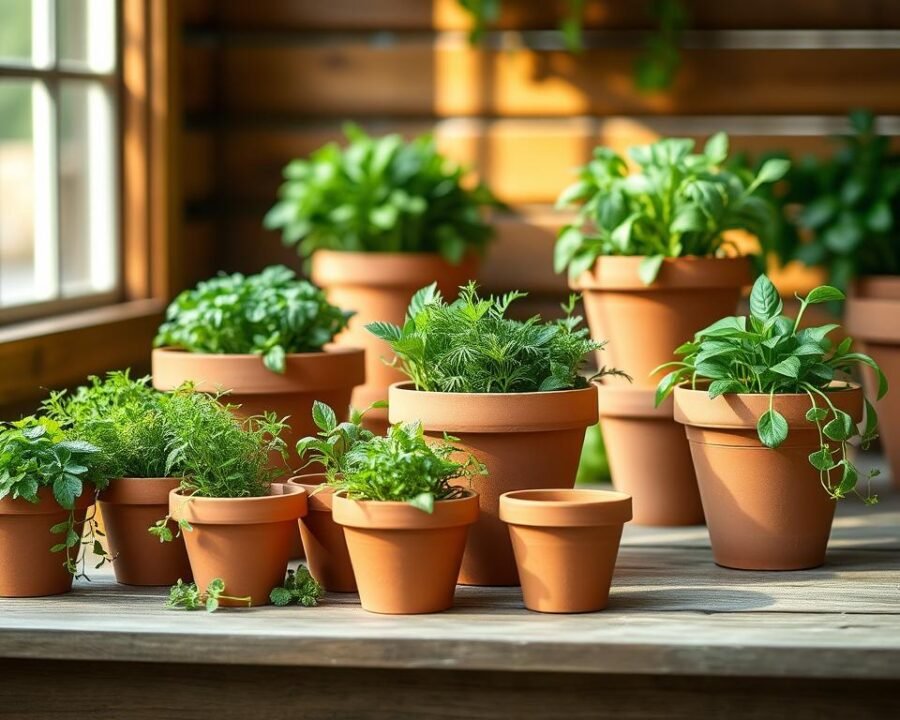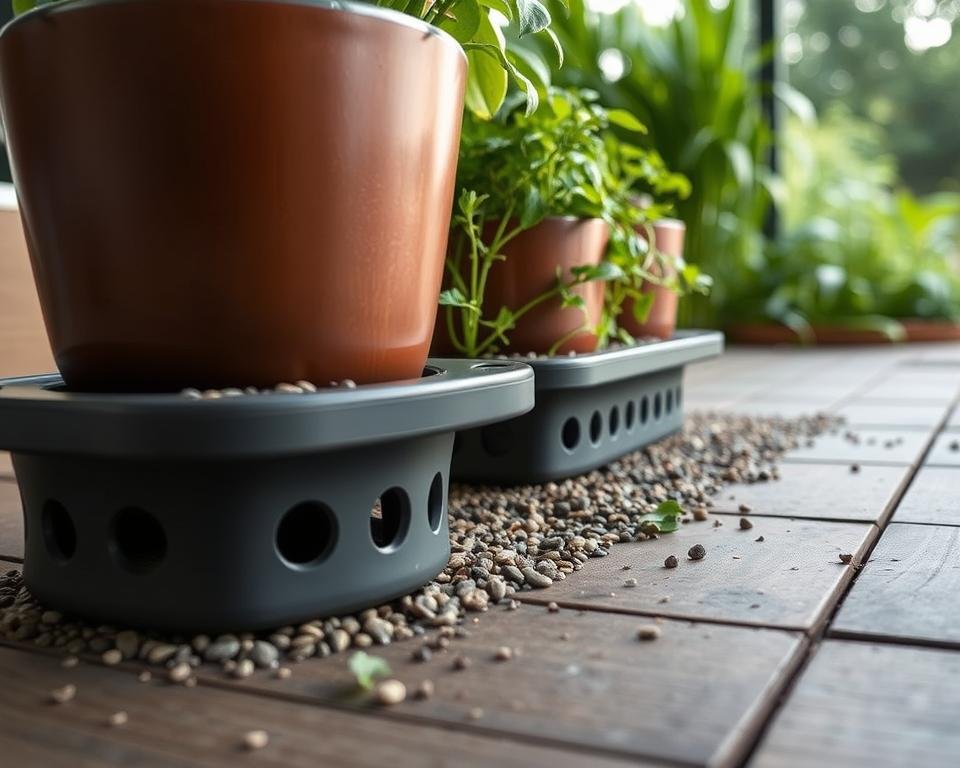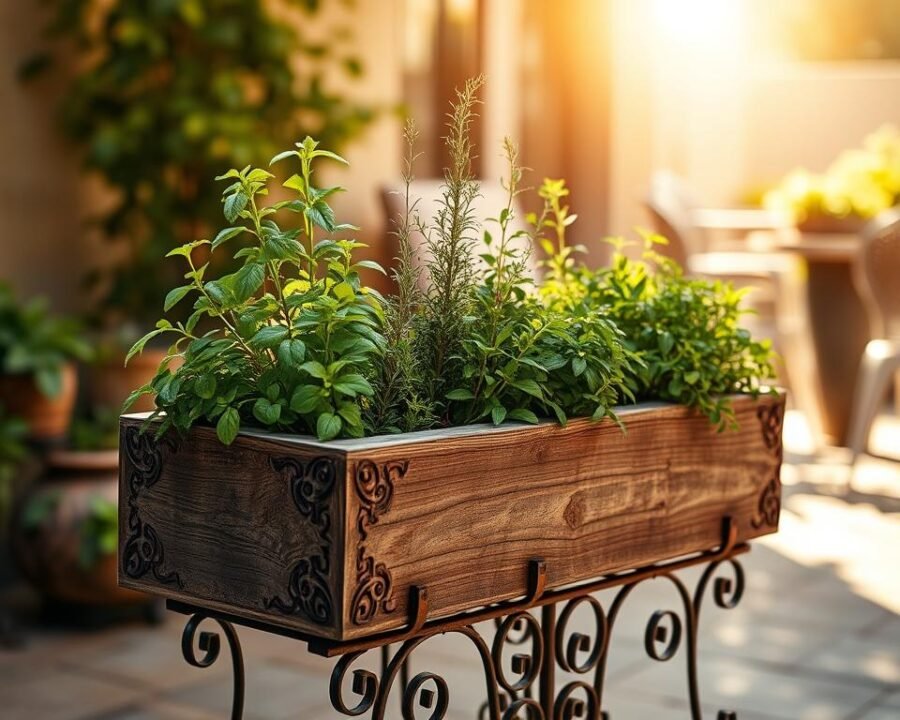Ever dreamed of fresh basil for your pasta or mint for your tea, just steps away from your kitchen? Growing your own herbs is easier than you think—even in small spaces. Whether you have a sunny balcony, a tiny patio, or just a windowsill, a well-chosen planter can turn any spot into a thriving mini-garden.
We’ve found that starting with resilient varieties like chives makes the process simple. These hardy greens grow quickly, offering fresh cuttings every few days. No more wilted store-bought bunches—just snip what you need, when you need it.
Urban living doesn’t have to mean sacrificing greenery. Compact solutions like window boxes or hanging planters keep things tidy while maximizing space. The right container not only fits your lifestyle but also ensures your herbs flourish.
Key Takeaways
- Fresh herbs can thrive in small spaces like balconies or windowsills.
- Beginner-friendly options like chives offer quick harvests.
- Homegrown herbs save money compared to store-bought ones.
- Specialty planters adapt to urban living constraints.
- Choosing the right container boosts growing success.
Why Growing Herbs in Planters Is a Game-Changer
Urban living often means limited outdoor space, but growing herbs in containers solves this challenge. Unlike traditional plots, these compact systems fit balconies, windowsills, or even walls. No yard? No problem.
Space-Smart Solutions for City Dwellers
Over 70% of urban growers say space is their biggest hurdle. Containers turn wasted corners into productive spots. Stackable designs use vertical space, doubling your growing area without clutter.
For example, basil thrives when moved from east to west windows for optimal light. Heavy terra cotta stays put, while lightweight plastic lets you shuffle plants easily. Bonus: Elevated planters deter pests like slugs.
Sunlight and Seasonal Flexibility
Containers adapt to your home’s microclimates. Rotate mint to shade in summer or shift rosemary to sunny spots in winter. This control boosts yields year-round.
| Material | Weight | Best For |
|---|---|---|
| Terra Cotta | Heavy | Stable, sunny spots |
| Plastic | Light | Frequent relocation |
| Resin | Medium | Balcony aesthetics |
Therapeutic perks add value. Studies show tending plants reduces stress. Plus, fresh flavors elevate meals—no grocery runs required.
Choosing the Right Material for Your Herb Planter
Material choice impacts plant health more than most realize—pick wisely. Each option affects watering needs, root aeration, and even how long your pots last. We’ll break down the pros and cons of popular materials.

Ceramic Pots: Stylish but Heavy
Glazed ceramic pots add elegance but weigh 8–12 lbs empty. Their heft stabilizes tall plants like rosemary. However, they’re prone to cracking in freezing temps. Tip: Use them indoors or in mild climates.
Terra Cotta: Breathable and Classic
Porous clay lets roots breathe, reducing overwatering risks. Studies show terra cotta cuts watering frequency by 30%. Yet, they dry out faster in sun—ideal for drought-tolerant thyme or oregano.
Plastic: Lightweight and Moisture-Retentive
Plastic containers retain water, perfect for basil or mint. Their lightness makes rearranging easy. Opt for UV-resistant types to prevent sun damage. Budget-friendly and recyclable, they’re a pragmatic pick.
Metal and Resin: Modern Alternatives
Resin withstands -20°F to 120°F, outperforming most materials. Metal pots conduct heat, risking root burn—line them with coconut coir. Both offer sleek designs for balconies.
| Material | Best For | Lifespan |
|---|---|---|
| Ceramic | Indoor/decorative | 5+ years |
| Terra Cotta | Mediterranean herbs | 3–5 years |
| Plastic | Moisture-loving herbs | 2–4 years |
| Resin | Extreme climates | 7+ years |
Match materials to your herbs’ needs. Deep-rooted parsley thrives in breathable clay, while shallow-rooted chives suit plastic. Always prioritize drainage—drill holes if needed.
Planter Size Matters: Matching Pots to Your Herbs
Root health starts with choosing the correct container dimensions. Too small, and roots circle tightly, stunting growth. Too large, and excess soil retains water, raising rot risks by 40%. We’ll guide you through the ideal pairings.

Compact Varieties Thrive in 6-Inch Pots
Thyme, oregano, and dwarf basil flourish in small containers. Their shallow root systems need just 6 inches of soil depth. Pro tip: Group these in a single wide pot for a mini herb cluster.
Mid-Sized Pots (8–10 Inches) Offer Flexibility
Most culinary favorites—like cilantro and chives—fit here. These pots balance space and moisture control. Warning: Ceramic options over 10 inches become heavy—reinforce shelves.
“Parsley’s taproot grows vertically, requiring 14 inches of unobstructed depth for optimal development.”
Deep Containers (12–18 Inches) for Taproots
Parsley, dill, and fennel demand depth. Their long roots mine nutrients from lower soil layers. Pair them with moisture-retentive plastic to reduce watering frequency.
- Weight distribution: Place large pots on wheeled trays for easy movement.
- Companion planting: Mix basil (shallow) with parsley (deep) in 12-inch pots.
- Vertical hacks: Use stackable planters to save floor space.
Drainage: The Secret to Healthy Herb Plants
Proper drainage separates thriving plants from waterlogged disasters. Without it, roots suffocate, and mold thrives. One simple feature—drainage holes—makes all the difference.

Why Drainage Holes Are Non-Negotiable
Roots need oxygen as much as water. Standing water creates anaerobic conditions, inviting root rot. Studies show proper drainage reduces rot risks by 80%.
Lavender and rosemary demand fast-drying soil. Their roots rot quickly in stagnant water. Even moisture-loving basil suffers without airflow.
How to Add Holes to Decorative Pots
Many stylish containers lack drainage. Fix this with a 3/8″ drill bit and steady hands. For ceramic pots, use a masonry bit and low speed to prevent cracks.
- Mark hole locations evenly across the base
- Place painter’s tape to reduce chipping
- Drill at 45° initially, then straighten
Using Saucers to Protect Indoor Surfaces
Saucers catch runoff but affect evaporation. Plastic saucers hold water longer than terra cotta. Match saucer size to your pot’s diameter—1″ wider prevents spills.
For humidity control, elevate pots on pebble trays. This creates air gaps while containing drips.
“Overwatering kills more herbs than drought. Always err on the dry side.”
Seasonal adjustments help too. Reduce saucer use in winter when evaporation slows. In summer, check them twice daily—overflow attracts pests.
Specialty Herb Planters for Unique Needs
Not all growing spaces are created equal—specialty planters solve unique challenges. Whether you’re short on time, counter space, or outdoor access, innovative designs keep herbs thriving. We’ll explore three tailored solutions for modern growers.
Self-Watering Systems for Busy Gardeners
The Modern Sprout Eco Planter uses a wick system to reduce watering by 70%. Its reservoir feeds roots gradually, perfect for vacations or hectic schedules. Bonus: These planters prevent overwatering, a common killer of basil and mint.
Window Boxes for Sunny Kitchens
South-facing windows with 8+ hours of sunlight? Install a window box for instant access to cooking staples. Choose lightweight resin to avoid straining frames. Pro tip: Pair thyme and sage—they thrive in the same bright, dry conditions.
Hanging Planters for Small Spaces
Tension rod planters maximize vertical space in apartments. Ensure hardware supports 15+ lbs when wet. For windy balconies, opt for sturdy rosemary or chives—their flexible stems resist breakage.
| Planter Type | Best For | Key Feature |
|---|---|---|
| Self-Watering | Busy lifestyles | 70% less water use |
| Window Box | Kitchen access | 8-hour sunlight minimum |
| Hanging | Space constraints | Childproof brackets available |
For urban settings, theft-resistant designs with locking brackets add security. ADA-compliant vertical gardens extend accessibility, proving anyone can grow fresh flavors.
Our Top Picks for the Best Herb Garden Planter You Need to Try
Quality planters make all the difference in nurturing fresh, flavorful herbs. We tested dozens of options to find the most reliable designs for every need—whether you prioritize style, affordability, or low-maintenance care.
Bergs Glazed Palace Pot: Premium Ceramic Choice
This 11-inch ceramic pot combines elegance with functionality. Its two drainage holes prevent overwatering, while the glossy finish suits modern kitchens. Note: Weighs 9 lbs empty—ideal for stable indoor placement.
H Potter Herb Planter: Budget-Friendly Set
At $22 for three pots, this set offers unbeatable value. The lightweight resin material resists cracking, and the tiered design saves space. Perfect for beginners looking to get started without a big investment.
Modern Sprout Eco Planter: Self-Watering Innovation
Its 2-week water reservoir eliminates guesswork. The wick system delivers moisture evenly, reducing maintenance by 70%. Make sure to place it in bright, indirect light for optimal growth.
| Feature | Bergs Pot | H Potter | Modern Sprout |
|---|---|---|---|
| Price | $45 | $22 | $60 |
| Assembly | None | 5 minutes | 10 minutes |
| Warranty | 2 years | 1 year | 5 years |
Each option includes theft-proof features like locking brackets for porch use. Sustainability certifications ensure eco-friendly materials, and packaging is designed to survive shipping.
Herb Pairing and Care Tips for Thriving Plants
Sunlight and water form the foundation of healthy, flavorful herbs. Pairing the right varieties with tailored care ensures robust growth and potent aromas. Let’s explore how to optimize light, moisture, and nutrients for your greens.
Maximizing Sunlight for Potent Flavors
Most culinary herbs demand 8+ hours of direct sunlight daily. Rosemary, for instance, produces 18% more essential oils under full sun. Use a light meter to identify bright spots—south-facing windows or balconies work best.
Group herbs by light needs. Mediterranean varieties like thyme and oregano thrive together in sunny patches. Shade-tolerant mint or parsley can occupy dimmer corners.
Watering Smart to Prevent Root Rot
Overwatering kills more plants than drought. Check soil moisture by inserting a finger 1 inch deep—water only if dry. Pro tip: Morning watering reduces evaporation loss.
- Terracotta pots: Water every 2–3 days (porous material dries faster).
- Plastic/resin: Stretch to 4–5 days between sessions.
- Self-watering systems: Refill reservoirs weekly.
Fertilizing Without the Burn
Liquid seaweed boosts yields by 25% without chemical risks. Apply diluted solutions every 3 weeks in growing season. Avoid granular fertilizers—they often concentrate in small containers, scorching roots.
“Herbs prefer lean soil. Over-fertilizing leads to lush leaves but weak flavors.”
For pH balance, mix 1 tbsp vinegar per gallon of tap water for alkaline-loving basil. Test soil annually to adjust amendments like compost or perlite.
Conclusion
Fresh flavors at your fingertips begin with the right setup. Whether choosing terra cotta for breathability or self-watering pots for convenience, each detail impacts your herbs’ success. Start with hardy varieties like chives—they’re forgiving and quick to harvest.
Ready to get started? Pick a planter that fits your space and sunlight. Share your progress with fellow growers, or join our newsletter for seasonal tips. Small steps lead to big rewards.
Every garden thrives with patience and care. What will you grow first?
